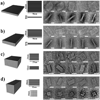Multilayer DNA origami packed on a square lattice
- PMID: 19807088
- PMCID: PMC2821935
- DOI: 10.1021/ja906381y
Multilayer DNA origami packed on a square lattice
Abstract
Molecular self-assembly using DNA as a structural building block has proven to be an efficient route to the construction of nanoscale objects and arrays of increasing complexity. Using the remarkable "scaffolded DNA origami" strategy, Rothemund demonstrated that a long single-stranded DNA from a viral genome (M13) can be folded into a variety of custom two-dimensional (2D) shapes using hundreds of short synthetic DNA molecules as staple strands. More recently, we generalized a strategy to build custom-shaped, three-dimensional (3D) objects formed as pleated layers of helices constrained to a honeycomb lattice, with precisely controlled dimensions ranging from 10 to 100 nm. Here we describe a more compact design for 3D origami, with layers of helices packed on a square lattice, that can be folded successfully into structures of designed dimensions in a one-step annealing process, despite the increased density of DNA helices. A square lattice provides a more natural framework for designing rectangular structures, the option for a more densely packed architecture, and the ability to create surfaces that are more flat than is possible with the honeycomb lattice. Thus enabling the design and construction of custom 3D shapes from helices packed on a square lattice provides a general foundational advance for increasing the versatility and scope of DNA nanotechnology.
Figures



References
-
- Tseng AA. Small. 2005;10:924–939. - PubMed
-
- Seeman NC. Nature (London, U. K.) 2003;421:427–431. - PubMed
- He Y, Ye T, Su M, Zhang C, Ribble AE, Jiang W, Mao C. Nature. 2008;452:198–201. - PubMed
- Zhang C, Su M, He Y, Zhao X, Fang P, Ribble AE, Jiang W, Mao C. Proc. Natl. Acad. Sci. U.S.A. 2008;105:10665–10669. - PMC - PubMed
- Shih WM, Quispe JD, Joyce GF. Nature. 2004;427:618–621. - PubMed
- Winfree E, Liu F, Wenzler LA, Seeman NC. Nature (London) 1998;394:539–544. - PubMed
- Aldaye FA, Sleiman HF. J. Am. Chem. Soc. 2009;129:13376–13377. - PubMed
- Fu TJ, Seeman NC. Biochemistry. 1993;32:3211–3220. - PubMed
- Li X, Yang X, Qi J, Seeman NC. J. Am. Chem. Soc. 1996;118:6131–6140.
- Rothemund PWK, Ekani-Nkodo A, Papadakis N, Kumar A, Fygenson DK, Winfree E. J. Am. Chem. Soc. 2004;126:16344–16352. - PubMed
- Mathieu F, Liao S, Kopatsch J, Wang T, Mao C, Seeman NC. Nano Lett. 2005;5:661–665. - PMC - PubMed
- Yin P, Hariadi RF, Sahu S, Choi HMT, Park SH, LaBean TH, Reif JH. Science. 2008;321:824–826. - PubMed
- Goodman RP, Schaap IAT, Tardin CF, Erben CM, Berry RM, Schmidt CF, Turberfield AJ. Science. 2005;310:1661–1665. - PubMed
- Chen J, Seeman NC. Nature (London) 1991;350:631–633. - PubMed
- Zhang Y, Seeman NC. J. Am. Chem. Soc. 1994;116:1661–1669.
-
- Yan H, Park SH, Finkelstein G, Reif JH, LaBean TH. Science. 2003;301:1882–1884. - PubMed
-
- Park SH, Yin P, Liu Y, Reif JH, LaBean TH, Yan H. Nano Lett. 2005;5:729–733. - PubMed
Publication types
MeSH terms
Substances
Grants and funding
LinkOut - more resources
Full Text Sources
Other Literature Sources

